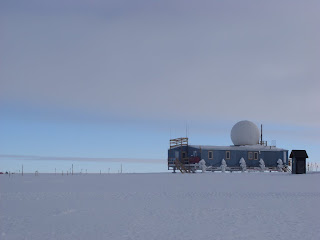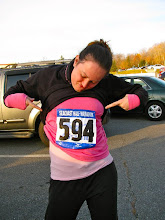A busy week is to blame for my e-absence. In the past seven days, we did our last 48-hr sample, our last snow pit, another mist chamber calibration, shut down the instruments, and packed up the tomato and Bally building. That's right: packed up. We're done! Our last sample was taken Monday evening. It's a bit bittersweet, though, I will admit, more sweet than bitter. This has been an amazing experience and I've met some great people in my 3-week stint on two miles of ice but I'm ready to see a night sky, greenery, and some warmer temps. Oh and I suppose family and friends as well.
Tomorrow marks my last day on the ice sheet. Well, hopefully. There's always a high probability that the plane won't come due to bad weather, which, let's face it, is not uncommon up here in the Arctic. If the plane does come (finger tightly crossed!), myself and six others will be delivered back down to sea-level, to Kangerlussuaq. The flight to Kanger is only an hour and half which is great. What's not great is that our flight tomorrow is what they refer to as a cold deck. As we will be traveling with the snow samples my colleagues and I collected as well as all the ice cores (35 boxes of ~6 1 meter cores), they have to keep the flight deck cold. To do this, they use the outside air, which at altitude, will be a chilly minus twenty-something celsius (below zero fahrenheit). Layers will be key! I also plan to bring my sleeping bag with me.
Once again, my time in Kanger will be limited; my flight back to the states is the following morning likely at 8 or 9. I'm not terribly dissapointed to breeze through Kanger though it would be nice to have some time to buy some gifts and/or head to the ice edge. Perhaps one or the other will be possible once we get in. IF we get in. Always have to keep that in mind!
While I may be leaving science will continue. Just yesterday, we had a batch of 12 new people arrive to Summit ready to either start projects or to take over projects already in action. Two projects that will continue long after I leave Summit are the Unmanned Aerial Vehicle (UAV) project and Radiosonde launches. Unlike the other ground-based projects I've talked about here, these two are airborne.
The radiosonde (pronounced radio-sond) launches are actually associated with the project examining Arctic cloud structure that I mentioned briefly a while back. The sonde's purpose is to get vertical profiles of temperature and humidity, two variables that are very useful in determining how favorable the atmosphere is for storm, cloud, and fog formation (i.e., atmospheric stability). Radiosondes are launched at the same time, twice a day around the world yielding a synchronous and global look at the atmosphere above.
The radiosonde itself (shown being assembled by Brad below) is a very small box off of which hang temperature and humidity probes. A small water-activated battery powers the instrument.
 This tiny box is attached to an extremely large balloon which carries the instrument tens of thousands of kilometers up into the stratosphere. At this point the balloon pops and falls to the surface, landing somewhere in the great white open. Brad was kind enough to allow me to take a video of the radiosonde launch:
This tiny box is attached to an extremely large balloon which carries the instrument tens of thousands of kilometers up into the stratosphere. At this point the balloon pops and falls to the surface, landing somewhere in the great white open. Brad was kind enough to allow me to take a video of the radiosonde launch:If you listen closely (and the sound uploads!) you can here wish the sonde off. While the process wasn't terribly interesting the data that come out of it, are extremely useful.
Though the UAV project doesn't involve balloons, it does call up another type of toy: a model airplane. Ok, it's a REEEEEALLY big model airplane (4 meter-13 feet-wing span) but still, same principle. The planes are built and operated by a group out of Norway. These scientists are interested in surface albedo and what a better way to see how much solar radiation is reflecting off the surface than to measure it from above? On the plane are housed two spectrometers that do just that as shown in the picture below.

Unfortunately, I was too late to the UAV site to catch pictures of the plane in action hence the pictures of the disassembled aircraft. The launch is pretty rad though and takes place on this "catapult" shown below.

I don't know about you, but when I think catapult I think medieval warfare and giant wooden weapon that fling balls of burning hay (or whatever), not so much a sleek metal ramp. But, hey I'm not an engineer. Compressed air pushes the airplane into the air and away it goes; looking at the radiation being reflected on the snowy surface below.
I really hope tomorrow I will be looking at Summit from above. Ok, so it wouldn't be the worse thing to be stranded up here (did I mention the food is outrageously good?) but I'm more than ok with heading South. Here's hopin' for a good flying day!































